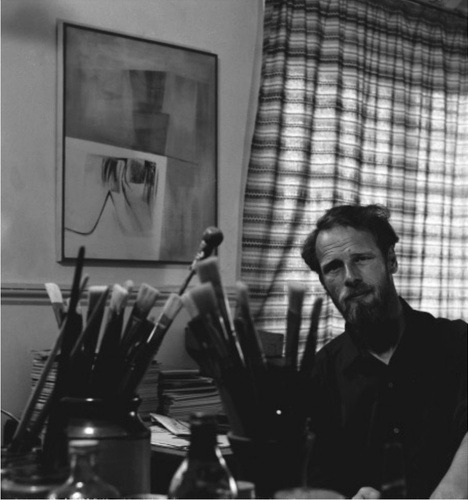Alexander Mackenzie Paintings for Sale1922-2002
Painter of abstracts, collagist, draughtsman and teacher, Alexander Mackenzie was born in Liverpool and been described as 'a powerful and distinctive member of the post-war generation of Modernists at St Ives when the art colony was a hotbed of new talent.'
The wartime evacuation of Mackenzie’s boarding school to Newburgh Priory in north Yorkshire initiated his appreciation of the past, the natural world and the history of art.He served as a driver in the Inns of Court Regiment, part of the 11th Armoured Brigade that raced across France, Holland and Germany in the months after D-day. Mackenzie studied at Liverpool College of Art before accepting a teaching post at Lescudjack School in Cornwall, were he taught 1951-64. His paintings of the 1950s occupied the same territory as the early landscape abstractions of his contemporary, Peter Lanyon, but had the rigour and coolness of Ben Nicholson.He then spent 20 years as head of the fine art department at Plymouth College of Art and Design. Mackenzie soon established close relationships with many artists including Ben Nicholson, Barbara Hepworth and John Wells.
Mackenzie began to exhibit at the Redfern Gallery in London, and from 1959 to 1963 had a succession of exhibitions at Waddington Galleries. Works were acquired for the Arts Council and the Tate. Herbert Read and Roland Penrose praised "his discrimination" and "the well-ordered arrangements of his canvases". Mackenzie had solo shows at New York's prestigious Durlacher Gallery in 1960 and 1962, and got to know Franz Kline, who was attracted to Mackenzie's Cornish roots. In the early 60s he was at the heart of attempts to revitalise the Penwith Society as an exhibiting co-operative. His later works were uncompromising: the drawing linear and tough, the limited palettes dominated by bone whites, cool greens and browns, and the textures scarred and distressed.
Interest in his work was revived in the 1990s by the Tate St Ives and dealers such as Keith Chapman and Austin Desmond. Apart from showing with the Penwith Society, he had little to do with the increasingly repetitious art scene in St Ives; but his last London exhibition, in 2000 at Austin Desmond, was a triumph.David Bowie was one of Mackenzie's biggest collectors.
Mackenzie’s works can now be found in the permanent collections of Arts Council, the Gulbenkian Foundation and many other provincial galleries.
